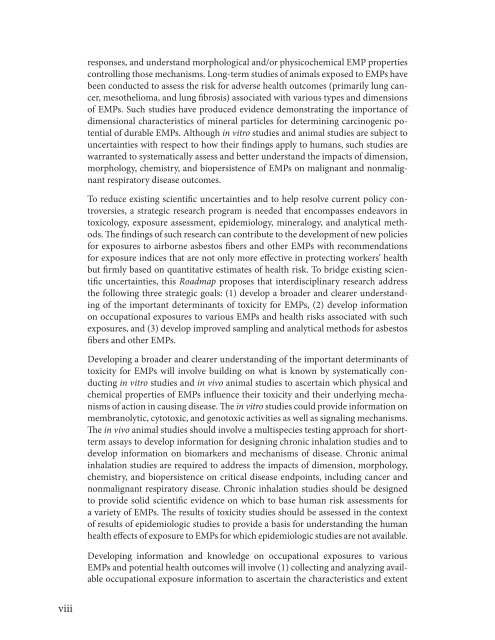Asbestos Fibers and Other Elongate Mineral Particles: State of the ...
Asbestos Fibers and Other Elongate Mineral Particles: State of the ...
Asbestos Fibers and Other Elongate Mineral Particles: State of the ...
- No tags were found...
You also want an ePaper? Increase the reach of your titles
YUMPU automatically turns print PDFs into web optimized ePapers that Google loves.
viii<br />
responses, <strong>and</strong> underst<strong>and</strong> morphological <strong>and</strong>/or physicochemical EMP properties<br />
controlling those mechanisms. Long-term studies <strong>of</strong> animals exposed to EMPs have<br />
been conducted to assess <strong>the</strong> risk for adverse health outcomes (primarily lung cancer,<br />
meso<strong>the</strong>lioma, <strong>and</strong> lung fibrosis) associated with various types <strong>and</strong> dimensions<br />
<strong>of</strong> EMPs. Such studies have produced evidence demonstrating <strong>the</strong> importance <strong>of</strong><br />
dimensional characteristics <strong>of</strong> mineral particles for determining carcinogenic potential<br />
<strong>of</strong> durable EMPs. Although in vitro studies <strong>and</strong> animal studies are subject to<br />
uncertainties with respect to how <strong>the</strong>ir findings apply to humans, such studies are<br />
warranted to systematically assess <strong>and</strong> better underst<strong>and</strong> <strong>the</strong> impacts <strong>of</strong> dimension,<br />
morphology, chemistry, <strong>and</strong> biopersistence <strong>of</strong> EMPs on malignant <strong>and</strong> nonmalignant<br />
respiratory disease outcomes.<br />
To reduce existing scientific uncertainties <strong>and</strong> to help resolve current policy controversies,<br />
a strategic research program is needed that encompasses endeavors in<br />
toxicology, exposure assessment, epidemiology, mineralogy, <strong>and</strong> analytical methods.<br />
The findings <strong>of</strong> such research can contribute to <strong>the</strong> development <strong>of</strong> new policies<br />
for exposures to airborne asbestos fibers <strong>and</strong> o<strong>the</strong>r EMPs with recommendations<br />
for exposure indices that are not only more effective in protecting workers’ health<br />
but firmly based on quantitative estimates <strong>of</strong> health risk. To bridge existing scientific<br />
uncertainties, this Roadmap proposes that interdisciplinary research address<br />
<strong>the</strong> following three strategic goals: (1) develop a broader <strong>and</strong> clearer underst<strong>and</strong>ing<br />
<strong>of</strong> <strong>the</strong> important determinants <strong>of</strong> toxicity for EMPs, (2) develop information<br />
on occupational exposures to various EMPs <strong>and</strong> health risks associated with such<br />
exposures, <strong>and</strong> (3) develop improved sampling <strong>and</strong> analytical methods for asbestos<br />
fibers <strong>and</strong> o<strong>the</strong>r EMPs.<br />
Developing a broader <strong>and</strong> clearer underst<strong>and</strong>ing <strong>of</strong> <strong>the</strong> important determinants <strong>of</strong><br />
toxicity for EMPs will involve building on what is known by systematically conducting<br />
in vitro studies <strong>and</strong> in vivo animal studies to ascertain which physical <strong>and</strong><br />
chemical properties <strong>of</strong> EMPs influence <strong>the</strong>ir toxicity <strong>and</strong> <strong>the</strong>ir underlying mechanisms<br />
<strong>of</strong> action in causing disease. The in vitro studies could provide information on<br />
membranolytic, cytotoxic, <strong>and</strong> genotoxic activities as well as signaling mechanisms.<br />
The in vivo animal studies should involve a multispecies testing approach for shortterm<br />
assays to develop information for designing chronic inhalation studies <strong>and</strong> to<br />
develop information on biomarkers <strong>and</strong> mechanisms <strong>of</strong> disease. Chronic animal<br />
inhalation studies are required to address <strong>the</strong> impacts <strong>of</strong> dimension, morphology,<br />
chemistry, <strong>and</strong> biopersistence on critical disease endpoints, including cancer <strong>and</strong><br />
nonmalignant respiratory disease. Chronic inhalation studies should be designed<br />
to provide solid scientific evidence on which to base human risk assessments for<br />
a variety <strong>of</strong> EMPs. The results <strong>of</strong> toxicity studies should be assessed in <strong>the</strong> context<br />
<strong>of</strong> results <strong>of</strong> epidemiologic studies to provide a basis for underst<strong>and</strong>ing <strong>the</strong> human<br />
health effects <strong>of</strong> exposure to EMPs for which epidemiologic studies are not available.<br />
Developing information <strong>and</strong> knowledge on occupational exposures to various<br />
EMPs <strong>and</strong> potential health outcomes will involve (1) collecting <strong>and</strong> analyzing available<br />
occupational exposure information to ascertain <strong>the</strong> characteristics <strong>and</strong> extent

















